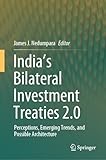India's Bilateral Investment Treaties 2. 0 : Perceptions, Emerging Trends, and Possible Architecture / Edited by James J. Nedumpara
Publication details: Singapore Springer Nature 2024Description: xxvii, 257 pages 24 cmISBN:- 9789819734009 (Hardback)
- 346.54092
| Item type | Current library | Shelving location | Call number | Materials specified | Status | Notes | Barcode | |
|---|---|---|---|---|---|---|---|---|
 BOOKs
BOOKs
|
National Law School | REFERENCE SECTION | 346.54092 NED (Browse shelf(Opens below)) | HB | Not For Loan | Recommended by Dr. Harisankar K Sathyapalan | 39920 |
Introduction: India’s Bilateral Investment Treaties 2.0: Imagining a New Model of Investment Promotion and Protection;
Investor Perceptions on International Investment Agreements: Evidence from India;
Thinking Beyond the International Investment Treaties: Alternative Models for Investment Protection and Dispute Resolution;
Addressing Corruption: Reimagining India’s Investment Treaties;
Sustainability in Investment Treaties: What the Future Holds?;
Investment Liberalisation in Trade Agreements: Filling a Gap in India’s Approach;
Investment Treaties and the Role of the Judiciary: Mapping Indian Judiciary’s Approach Post 2015 Model BIT;
The Role of India’s Investor–State Disputes in Shaping India’s Investment Treaty Policy;
Conclusion;
Index.
The book provides a deep and insightful enquiry into a set of persistent questions about investment treaties, including the causal relationship between investment treaties and investment, and their role in emerging economies such as India. It is innovative and pathbreaking as it distils past practices and experiences of investment treaties, from local and global perspectives, and seeks to sketch a template that could mark the next generation of bilateral investment treaties (BITs) for emerging economies, including India.
The book provides an authoritative account of whether the investment community accords importance to the existence of investment treaties while taking investment decisions, based on cross-country ethnographic research involving some of the key stakeholders drawn from foreign investor community, academicians, leading practitioners and key policy makers. Among other topics, it discusses potential evolution of investment treaties and how next generation treaties should look like, drawing lessons from past experiences, current practices and most importantly, the outlook for India in its next stage of development.
The book is very useful for academic community studying international investment law (IIA). Domestic and international practitioners of law will find the book a must read as the topic is emerging as a vibrant field of practice and consulting, and the volume focuses on some of the most debated areas in IIA. The book contains interest areas for policy makers, especially those who work in the field of commerce and economic diplomacy. It is also immensely useful to treaty negotiators and professionals that actively assist and advise negotiating teams of BITs and other investment disciplines which are part of trade agreements.
There are no comments on this title.
